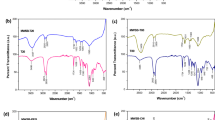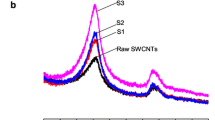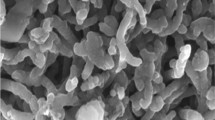Abstract
Sulforaphane is a naturally occurring active substance found in vegetables that is known for its potential in preventing and treating cancer. This compound has demonstrated promising effects in inhibiting the growth of various types of cancer, including esophageal, lung, colon, breast, and liver cancer. However, its instability towards pH and heat limits its application in the medical and food industries. To address this challenge, novel drug delivery systems have been developed to improve the stability and efficacy of sulforaphane, making it a more suitable candidate for clinical use in cancer research. In this study, nanocomposite materials were prepared using multi-walled carbon nanotubes (MWCNTs) and chitosan (CS) as base materials, with polydopamine (PDA) acting as a bridge material. The synthesized composite materials were used as drug carriers for the release of sulforaphane. The results of the study showed that the drug loading increased with an increase in the concentration of sulforaphane, indicating that the nanocomposite materials were effective in delivering and releasing the drug. Moreover, a positive correlation was observed between the drug loading and the thickness of the PDA layer. These findings suggest that the use of MWCNTs, CS, and PDA in the development of drug delivery systems can enhance the stability and efficacy of sulforaphane, potentially leading to improved cancer treatment outcomes.





Similar content being viewed by others
Data availability
The data that support the findings of this study are available from the corresponding author upon reasonable request.
References
Yagishita Y, Fahey JW, Dinkova-Kostova AT, Kensler TW (2019) Broccoli or sulforaphane: is it the source or dose that matters? Molecules 24:3593
Vanduchova A, Anzenbacher P, Anzenbacherova E (2019) Isothiocyanate from broccoli, sulforaphane, and its properties. J Med Food 22:121–126
Schepici G, Bramanti P, Mazzon E (2020) Efficacy of sulforaphane in neurodegenerative diseases. Int J Mol Sci 21:8637
Uddin MS, Al Mamun A, Jakaria M, Thangapandiyan S, Ahmad J, Rahman MA, Mathew B, Abdel-Daim MM, Aleya L (2020) Emerging promise of sulforaphane-mediated Nrf2 signaling cascade against neurological disorders. Sci Total Environ 707:135624
Zhang Y, Talalay P (1994) Anticarcinogenic activities of organic isothiocyanates: chemistry and mechanisms. Cancer Res 54:1976–1981
Hu R, Xu C, Shen G, Jain MR, Khor TO, Gopalkrishnan A, Lin W, Reddy B, Chan JY, Kong A-NT (2006) Gene expression profiles induced by cancer chemopreventive isothiocyanate sulforaphane in the liver of C57BL/6J mice and C57BL/6J/Nrf2 (−/−) mice. Cancer Lett 243:170–192
Morel F, Langouet S, Maheo K, Guillouzo A (1997) The use of primary hepatocyte cultures for the evaluation of chemoprotective agents. Cell Biol Toxicol 13:323–329
Thejass P, Kuttan G (2006) Antimetastatic activity of sulforaphane. Life Sci 78:3043–3050
Dinkova-Kostova AT, Jenkins SN, Fahey JW, Ye L, Wehage SL, Liby KT, Stephenson KK, Wade KL, Talalay P (2006) Protection against UV-light-induced skin carcinogenesis in SKH-1 high-risk mice by sulforaphane-containing broccoli sprout extracts. Cancer Lett 240:243–252
Ahmed S, Alhareth K, Mignet N (2020) Advancement in nanogel formulations provides controlled drug release. Int J Pharm 584:119435
Wang S, Yu G, Wang Z, Jacobson O, Lin L, Yang W, Deng H, He Z, Liu Y, Chen Z (2019) Enhanced antitumor efficacy by a cascade of reactive oxygen species generation and drug release. Angew Chem 131:14900–14905
Wells CM, Harris M, Choi L, Murali VP, Guerra FD, Jennings JA (2019) Stimuli-responsive drug release from smart polymers. J Funct Biomater 10:34
Zhang A, Jung K, Li A, Liu J, Boyer C (2019) Recent advances in stimuli-responsive polymer systems for remotely controlled drug release. Prog Polym Sci 99:101164
Pereira-da-Mota AF, Phan C-M, Concheiro A, Jones L, Alvarez-Lorenzo C (2022) Testing drug release from medicated contact lenses: the missing link to predict in vivo performance. J Control Release 343:672
Shi Z, Song Q, Göstl R, Herrmann A (2021) Mechanochemical activation of disulfide-based multifunctional polymers for theranostic drug release. Chem Sci 12:1668–1674
Abdeltawab H, Svirskis D, Sharma M (2020) Formulation strategies to modulate drug release from poloxamer based in situ gelling systems. Expert Opin Drug Deliv 17:495–509
Iijima S (1991) Helical microtubules of graphitic carbon. Nature 354:56–58
Liu Y, Huo Y, Fan Q, Li M, Liu H, Li B, Li Y (2021) Cellulose nanofibrils composite hydrogel with polydopamine@ zeolitic imidazolate framework-8 encapsulated in used as efficient vehicles for controlled drug release. J Ind Eng Chem 102:343–350
Rezk AI, Obiweluozor FO, Choukrani G, Park CH, Kim CS (2019) Drug release and kinetic models of anticancer drug (BTZ) from a pH-responsive alginate polydopamine hydrogel: towards cancer chemotherapy. Int J Biol Macromol 141:388–400
Uthappa U, Kigga M, Sriram G, Ajeya KV, Jung H-Y, Neelgund GM, Kurkuri MD (2019) Facile green synthetic approach of bio inspired polydopamine coated diatoms as a drug vehicle for controlled drug release and active catalyst for dye degradation. Microporous Mesoporous Mater 288:109572
Saitaer X, Sanbhal N, Qiao Y, Li Y, Gao J, Brochu G, Guidoin R, Khatri A, Wang L (2019) Polydopamine-inspired surface modification of polypropylene hernia mesh devices via cold oxygen plasma: antibacterial and drug release properties. Coatings 9:164
Karimi F, Korkmaz S, Karaman C, Karaman O, Kariper İA (2022) Engineering of GO/MWCNT/RuO2 ternary aerogel for high-performance supercapacitor. Fuel 329:125398
Mehmandoust M, Erk N, Karaman O, Karimi F, Bijad M, Karaman C (2021) Three-dimensional porous reduced graphene oxide decorated with carbon quantum dots and platinum nanoparticles for highly selective determination of azo dye compound tartrazine. Food Chem Toxicol 158:112698
Sun P, Liu Y, Mo F, Wu M, **ao Y, **ao X, Wang W, Dong X (2023) Efficient photocatalytic degradation of high-concentration moxifloxacin over dodecyl benzene sulfonate modified graphitic carbon nitride: enhanced photogenerated charge separation and pollutant enrichment. J Clean Prod 393:136320. https://doi.org/10.1016/j.jclepro.2023.136320
Zhu Y, Li X, Xu Y, Wu L, Yu A, Lai G, Wei Q, Chi H, Jiang N, Fu L (2021) Intertwined carbon nanotubes and Ag nanowires constructed by simple solution blending as sensitive and stable chloramphenicol sensors. Sensors 21:1220
Fu L, **e K, Zhang H, Zheng Y, Su W, Liu Z (2017) Multi-walled carbon nanotube-assisted electrodeposition of silver dendrite coating as a catalytic film. Coatings 7:232
Zheng Y, Fu L, Wang A, Cai W (2015) Electrochemical detection of quinoline yellow in soft drinks based on layer-by-layer fabricated multi-walled carbon nanotube. Int J Electrochem Sci 10:3530–3538
Fu L, Lai G, Zhang H, Yu A (2015) One-pot synthesis of multipod ZnO-carbon nanotube-reduced graphene oxide composites with high performance in photocatalysis. J Nanosci Nanotechnol 15:4325–4331
Brett CMA, Oliveira-Brett AM (2011) Electrochemical sensing in solution—origins, applications and future perspectives. J Solid State Electrochem 15:1487–1494. https://doi.org/10.1007/s10008-011-1447-z
Fu L, Yu A (2014) Carbon nanotubes based thin films: fabrication, characterization and applications. Rev Adv Mater Sci 36:40–61
Fu L, Lai G, Mahon PJ, Wang J, Zhu D, Jia B, Malherbe F, Yu A (2014) Carbon nanotube and graphene oxide directed electrochemical synthesis of silver dendrites. Rsc Adv 4:39645–39650
Lee H, Dellatore SM, Miller WM, Messersmith PB (2007) Mussel-inspired surface chemistry for multifunctional coatings. Science 318:426–430
Karaman C (2021) Orange peel derived-nitrogen and sulfur Co-doped carbon dots: a nano-booster for enhancing ORR electrocatalytic performance of 3D graphene networks. Electroanalysis 33:1356–1369
Kim HW, McCloskey BD, Choi TH, Lee C, Kim M-J, Freeman BD, Park HB (2013) Oxygen concentration control of dopamine-induced high uniformity surface coating chemistry. ACS Appl Mater Interfaces 5:233–238
Wang Y, Tang M, Lin X, Gao F, Li M (2012) Sensor for hydrogen peroxide using a hemoglobin-modified glassy carbon electrode prepared by enhanced loading of silver nanoparticle onto carbon nanospheres via spontaneous polymerization of dopamine. Microchim Acta 176:405–410
Chen S, Liu S, Zhang L, Han Q, Liu H, Shen J, Li G, Zhang L, Yang Y (2020) Construction of injectable silk fibroin/polydopamine hydrogel for treatment of spinal cord injury. Chem Eng J 399:125795
Viter R, Fedorenko V, Gabriunaite I, Tepliakova I, Ramanavicius S, Holubnycha V, Ramanavicius A, Valiūnienė A (2023) Electrochemical and optical properties of fluorine doped tin oxide modified by ZnO nanorods and polydopamine. Chemosensors 11:106
**ong C, Cao S, Wang Y, Wang X, Long S, Zhang G, Yang J (2019) Surface modification of polyarylene sulfide sulfone membrane by coating with polydopamine. J Coat Technol Res 16:643–650
Varma R, Vasudevan S (2020) Extraction, characterization, and antimicrobial activity of chitosan from horse mussel modiolus modiolus. ACS Omega 5:20224–20230
Avid A, Jafari SH, Khonakdar HA, Ghaffari M, Krause B, Pötschke P (2020) Surface modification of MWCNT and its influence on properties of paraffin/MWCNT nanocomposites as phase change material. J Appl Polym Sci 137:48428
Sun Z, Song C, Wang C, Hu Y, Wu J (2019) Hydrogel-based controlled drug delivery for cancer treatment: a review. Mol Pharm 17:373–391
Zheng P, Liu Y, Chen J, Xu W, Li G, Ding J (2020) Targeted pH-responsive polyion complex micelle for controlled intracellular drug delivery. Chin Chem Lett 31:1178–1182
Wang Y, Yu W, Niu C, Yu G, Huang X, Shi J, Ma D, Lin X, Zhao K (2022) A NIR light-activated PLGA microsphere for controlled release of mono-or dual-drug. Polym Test 116:107762
Corsaro C, Neri G, Mezzasalma AM, Fazio E (2021) Weibull modeling of controlled drug release from Ag-PMA Nanosystems. Polymers 13:2897
Peterlin A (1979) Diffusion with discontinuous swelling. V. Type II diffusion into sheets and spheres. J Polym Sci Polym Phys Ed 17:1741–1756
Funding
This work is financially supported by Cangzhou key research and development plan (183302065).
Author information
Authors and Affiliations
Contributions
Conceptualization, RL and LL; software, XH; validation, RL, and XH; formal analysis, XH, SS, and YL; investigation, RL, and WC; resources, WC and LL; data curation, XH, SS, and YL; writing—original draft preparation, XH, SS, YL and WC; writing—review and editing, RL and LL; visualization, XH; supervision, LL; project administration, LL. All authors have read and agreed to the published version of the manuscript.
Corresponding author
Ethics declarations
Conflict of interest
On behalf of all authors, the corresponding author states that there is no conflict of interest.
Additional information
Publisher's Note
Springer Nature remains neutral with regard to jurisdictional claims in published maps and institutional affiliations.
Rights and permissions
Springer Nature or its licensor (e.g. a society or other partner) holds exclusive rights to this article under a publishing agreement with the author(s) or other rightsholder(s); author self-archiving of the accepted manuscript version of this article is solely governed by the terms of such publishing agreement and applicable law.
About this article
Cite this article
Li, R., Hu, X., Shan, S. et al. Study on the controlled release properties of modified multi-walled carbon nanotubes on sulforaphane. Carbon Lett. 34, 757–765 (2024). https://doi.org/10.1007/s42823-023-00520-4
Received:
Revised:
Accepted:
Published:
Issue Date:
DOI: https://doi.org/10.1007/s42823-023-00520-4




